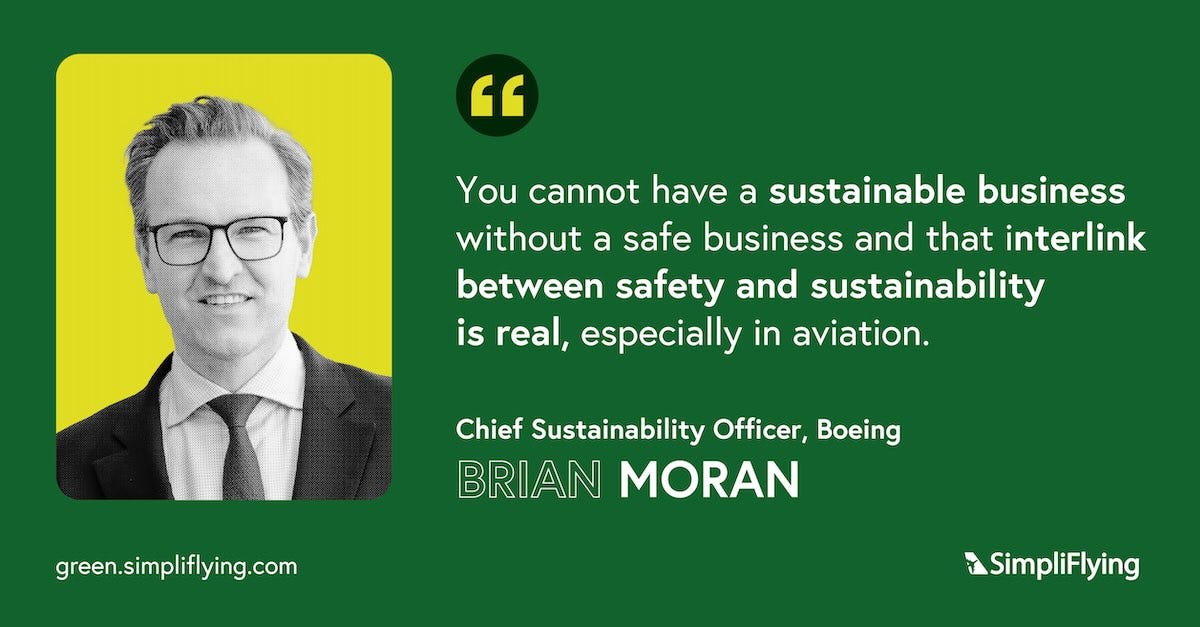In this episode of our ‘Sustainability in the Air’ podcast, Brian Moran, Chief Sustainability Officer at Boeing, speaks with SimpliFlying’s CEO Shashank Nigam, and shares the company’s multifaceted approach to decarbonising the aviation industry, focusing on sustainable aviation fuel (SAF), innovative technologies, and the importance of regaining trust in the wake of recent challenges.
Here are the key highlights of the conversation:
Boeing’s Cascade model for decarbonisation strategies (4:20)
Mandates vs. incentives for SAF adoption (10:20)
The cost and price dynamics of SAF (16:10)
Boeing’s three-pronged approach to SAF development (23:10)
Boeing’s investments in electric and hydrogen technologies (31:30)
The Wisk eVTOL project and its implications (37:15)
Rebuilding trust in Boeing through sustainability efforts (43:00)
Rapid Fire! (47:00)
Keep reading for a quick overview of the episode.
Why building trust matters
In recent times, Boeing has found itself in the midst of a major crisis, beginning with two fatal crashes involving the 737 Max in 2018 and 2019, aggravated by recent safety failures. In June 2024, Boeing’s CEO Dave Calhoun was also questioned by the US Senate about the company’s shortcomings and prevailing safety concerns.
Moran addresses Boeing’s efforts to rebuild trust in the wake of challenges and emphasises the interconnectedness of safety and sustainability. Boeing’s efforts in both areas are fundamental to the company’s success and its ability to regain the trust of customers, regulators, and the public, he adds. While the purpose of Boeing’s sustainability initiatives isn’t just trust-building, they certainly contribute to it, believes Moran. He views the current situation as an opportunity for open, transparent dialogue about Boeing’s shortcomings and remedial actions.
5 key takeaways from the conversation
1. Boeing’s multi-faceted role in advancing SAF
Boeing has been experimenting with SAF from as early as 2008, when they completed the first commercial SAF test flight with Virgin Atlantic. Last year, the aircraft manufacturer completed another significant milestone with the first-ever transatlantic flight using 100% SAF with the same airline. Other notable milestones include one in 2018 when the Boeing ecoDemonstrator flight test program made the world’s first commercial flight using 100% sustainable fuels with a 777 Freighter, in collaboration with FedEx Express and most recently when Boeing, NASA and others conducted flight tests to measure how SAF affects contrails and non-carbon emissions using a 737-10 destined for United Airlines.
“According to several studies SAF will contribute between 50%-70% of the total solution towards decarbonisation. That’s why Boeing has been so focused on it from the very first flight on SAF in 2008.”
Boeing’s SAF strategy, as Moran puts it, is three-pronged:
Technology development and de-risking, including extensive testing and certification processes.
Using SAF in their own operations, having purchased 35 million litres (equivalent to ~20% of their fuel use) to send a demand signal to the market.
Fostering regional SAF production capabilities through partnerships and studies.
Boeing has also committed to delivering all its new commercial aircraft as 100% SAF-compatible by 2030. Addressing the global equity concerns in SAF adoption, Moran notes that production won’t scale equally across all regions evenly and at the same time and suggests book and claim systems as a potential solution to the issue.
2. Driving SAF adoption: incentives vs. mandates
To accelerate the production and adoption of SAF, the EU employs a mandate-based approach, with the RefuelEU policy that directs fuel suppliers to ensure that all fuel made available to aircraft operators at EU airports contains a minimum share of SAF, starting 2025. Conversely, the US uses an incentive-based approach under the Inflation Reduction Act, which has attracted both domestic and European producers.
Acknowledging that incentives in the US have been “paying dividends” to boost SAF production, Moran calls for a balanced approach, citing Singapore’s model as an example. Singapore’s policy combines a mandate of 1% SAF 2026 onwards (and plans to raise it to 3-5% by 2030); with a passenger levy of about $3-$16 per ticket, using the revenue to purchase SAF and offset the associated green premium.
“What many forward-leaning regulators are realising is what we’re taxing – and what we’re talking about here – is preserving the social licence to fly and preserving the economic benefits of aviation. Benefits Beyond Borders, one of the ATAG reports, noted that (pre-pandemic) 4.1% of global GDP is directly dependent on aviation. That’s 87 million jobs and 7 trillion in goods delivered. That’s what we’re protecting here.”
3. Boeing’s five-lever Cascade model
In 2022, Boeing unveiled its dynamic data modelling tool called the Cascade to analyse various scenarios and strategies to help aviation achieve net-zero carbon emissions by 2050. Developed in collaboration with MIT, Cambridge, IATA, and NASA, Cascade uses data from reputable sources such as Cirium for traffic data, Boeing for aircraft performance models, and ICAO and IATA for operational efficiency data.
The Cascade model quantifies five different levers of improvement: fleet renewal, operational efficiency, renewable energy, future aircraft technology and market-based measures that include offsetting schemes like CORSIA.
The model visualises the climate impact of various decarbonisation strategies and accounts for full life-cycle emissions of different energy sources, helping users compare different choices and map out pathways to net-zero emissions. As such, the tool can be particularly useful to regulators, as it enables users to make more informed decisions about investments and policy.
“[The tool] lets you think through [questions like] what’s the relative impact of choice A versus choice B? What does my fleet look like in the future? What contribution can SAF make vis-a-vis hydrogen, for instance, in a place where there isn’t sufficient green hydrogen? What is my assumption on SAF availability, its life-cycle improvement? …and then starts mapping out over time, the path to net zero. But not all paths are equal. And depending on the region, you may not have at your disposal some of the choices that other regions do. And so [Cascade] allows you to really have an informed conversation.”
4. Investing in future technologies: electric and hydrogen propulsion
To promote electric propulsion, Boeing has joined NASA and GE Aerospace on the Electrified Powertrain Flight Demonstration (EPFD). The project involves retrofitting a Saab 340B turboprop aircraft with a megawatt-class hybrid engine. Boeing’s role focuses on aircraft modification, system integration, and flight-testing services for the flight demonstrator. Moran notes that while electric aircraft show promise for 200-300 nautical mile flights with 15-20 passengers, they cannot decarbonise the industry.
Another future technology that Boeing is exploring is hydrogen propulsion. Boeing has already conducted flight demonstrations. In 2012, they flew the Phantom Eye using liquid hydrogen propulsion. They also achieved a first by flying a two-seat Diamond aircraft powered by a hydrogen fuel cell from their Madrid research centre.
“[For the] EPFD… Boeing is providing a lot of the airplane integration and knowledge. Rewind 15 years: the 787 alone has more than a megawatt of onboard generated electricity. So we have a lot of knowledge on how to handle electric airplanes.”
5. eVTOLs and the Wisk Partnership
Boeing is exploring the possibilities of autonomous air taxis through its wholly-owned subsidiary Wisk. Moran frames Wisk as the embodiment of Boeing’s vision for the future of aerospace, which comprises four key aspects: “producibility (in terms of efficient and safe production), digitalisation, sustainability, and autonomy.” Wisk has currently progressed through 6 generations of development and completed over 1,600 autonomous missions.
“[Wisk is] the only company leading with a fully autonomous eVTOL. Most of our competitors are putting a pilot in the loop first, in the cockpit, and then may or may not think about going autonomous. We feel that going autonomous first is the right way forward.”
Emphasising Wisk’s unique approach of fully autonomous eVTOL (electric vertical take-off and landing) aircraft, compared to other manufacturers, Moran puts forth two main rationales for this strategy:
Enhanced safety through better management of high-volume air traffic
The pilot-less approach makes it more cost-competitive and economically viable
While acknowledging that eVTOLs may not significantly impact aviation’s carbon emissions directly, Moran believes the technological and operational learnings, including advancements in electrification, battery technology, and thermal management, would be fruitful for Boeing’s broader sustainable aviation efforts.
As Boeing navigates through its crisis, the company’s approach involves addressing safety issues head-on, maintaining transparency about its shortcomings, and continuing to invest in sustainable technologies. According to Moran, restoring stakeholder trust is a fundamental objective for Boeing, and while the company’s sustainability efforts are not primarily intended for trust-building, they can positively influence it. The effectiveness of this strategy, however, will hinge on Boeing’s ability to demonstrate consistent improvement in safety and sustainability over time.
‘Sustainability in the Air’ is the world’s leading podcast dedicated to sustainable aviation. Through in-depth conversations with top aviation leaders, we break through the clutter and provide a clear roadmap for a net-zero future.













